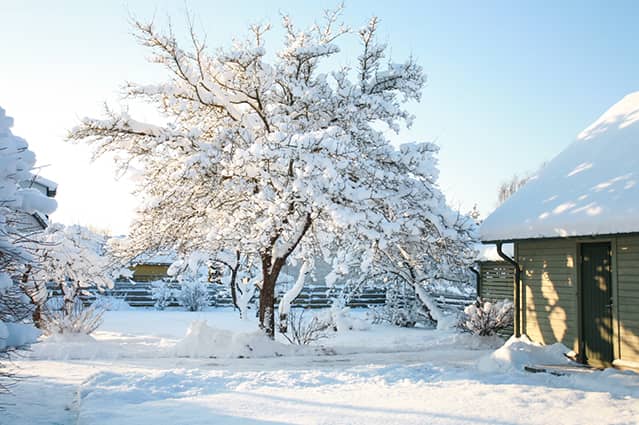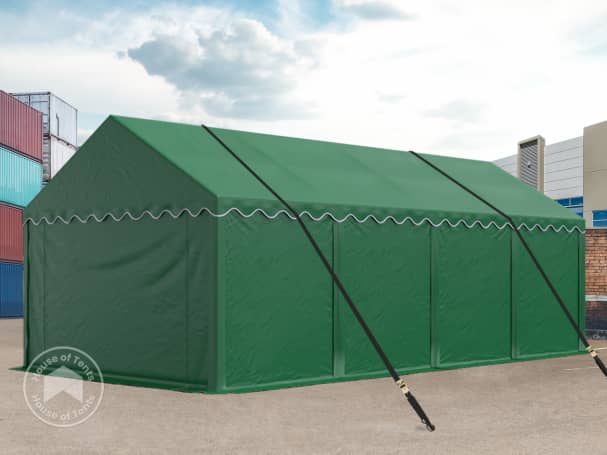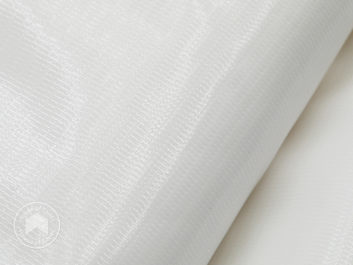
Increase the stability of your marquee or portable garage
Strong winds aren’t just a factor in autumn and winter. Adverse weather conditions can occur all year round. Particularly if your marquee is in use throughout the whole year or is left standing for several weeks, you will need to consider the possibilities for securing the structure and retrofit it with suitable anchoring equipment.
Here’s what you can expect to find in this article:
Snow, rain & wind - how to protect your tent from damage*
A marquee, gazebo or storage tent has many advantages over a fixed building. They’re very fast to put up, are portable, and are certainly cost effective!
You might even buy a marquee for temporary use over the summer, before realising just how reliable it can be at keeping the rain out and how useful it is expanding the sheltered space in your garden, or at your work place.
Perhaps when buying the marquee, the issues top of your mind were the marquee or gazebo’s capacity, UV protection, and its rugged good looks. As the weather takes a turn for the worse, its time to consider the structure’s susceptibility to heavy winds or a good dumping of snow. Even heavy rainfall must be taken into account, as, in combination with wind, rain pockets can form on the roof of a tent.
What you should bear in mind in all three scenarios is explained below.
Rain - how to prevent the formation of water pockets?
Storms often bring heavy rain, eg. greater than 10 mm per hour. Generally you can relax, knowing that all House of Tents tents are waterproof, and can expect the rain to drain freely from the slanted canopy of your heavy duty gazebo or tent. However, water pockets can form on the roof of a marquee or gazebo in heavy rain, particularly when a steady wind force is acting on the canopy.
So, it can happen that water pockets form on the roof sheet of your waterproof marquee. Unfortunately, the more water that collects, the lower the canopy sheet will sink, leaving more area for rainwater to collect. For this particular issue, there are two solutions: prevention, and treatment.

You can prevent the formation of water pockets by tensioning the roof tarpaulin of your marquee properly, ensuring it isn’t too loose or too tight. The location and assembly of the marquee is also very important. Make sure when you install the frame that it lies flat on the ground, and that the ground is level. Buying a marquee with additional roof supports, will greatly reduce both the likelihood of water pockets forming, and their extent if they do.
If water pockets do form, there is no need to panic. You can use the tried and true treatment of removing the water pockets with a broom. We recommend working with patience, slowly and carefully pushing the water over the side of the tent. Just be sure no one is sheltering outside next to the sidewall enjoying a cigarette!
Our tip:
It’s important that you react as quickly as possible and not allow too much time to elapse once the water pockets start to form. If you’re on the road, abroad, or at an event at the time of a big storm, its worth asking friends or family to lend a hand, pick up a broomstick, and relieve the stress on the canopy material.
Snow - protecting against a severe storm
Snow can accumulate and produce a thick layer over a matter of hours. This can have a devastating impact, first on the bungees connecting the canopy to the poles, and then on the tent fabric itself, stretching the bungees and canopy tarpaulin and even causing rips. If you live in northern regions, or at higher altitudes, it is recommended to buy a heavy duty tent with guaranteed snow loads.

Pop up gazebos are folding tents that are designed to be easy to put up and take down. We always recommend folding a pop up gazebo up in case of a snow storm.
At House of Tents, many of our professional products have been tested by engineers, and snowloads in kg/m² have been calculated. Important to note: The stated snow load for our products only refers to the supporting structure (the aluminium or steel frame).
Whether or not a snow load has been calculated: If heavy snowfall has been forecast, it’s advisable either to remove the tarpaulin completely, or to regularly remove snow from the roof tarpaulin (your broom will come in handy here too!)
Avoiding storm damage - make sure your tent can withstand strong winds
If gusty winds are forecast, appropriate measures should be taken without delay. Given that strong winds can uproot trees and rip the roof from permanent buildings, you should take a storm warning seriously.
Avoiding storm damage - make sure your tent can withstand strong winds
If gusty winds are forecast, appropriate measures should be taken without delay. Given that strong winds can uproot trees and rip the roof from permanent buildings, you should take a storm warning seriously.
- 1
Purchasing the right party tent or gazebo is crucial
Before any consideration of whether your marquee is securely anchored, you need to ensure that you are buying a strong, heavy duty frame and tarpaulin. Especially for year-round or commercial use, we recommend a waterproof, sturdy marquee with a PVC canopy and sides. Marquees with PE canopies and sides are also waterproof and UV-resistant, but PVC is heavier, more robust, and can be repaired/glued in an emergency. To get an idea of its durability, it has a similar feel as a truck tarpaulin. Another important point: PVC-coated marquees and gazebos are flame-resistant. At House of Tents you can get PVC tents in different sizes and colours – from a 3-metre wide gazebo with a 2 metre length, up to a size of 8×36 metres in e.g. white, grey-white, green, red-white and blue-white.
In our online shop, marquees with a PVC tarpaulin are part of the Profi-line of marquees. Premium Profi-line marquees feature a base frame and roof supports, ensuring much greater stability, while — for ideal storm protection — Professional models feature stronger, thicker leg poles in addition to the roof and floor reinforcements. A further consideration could be the standard economy marquee with PVC tarp. This model however lends itself more towards fine sunny days and will not fair as well in turbulent weather.
- 2
Prepare the location - give your marquee a great foundation
Finding the most suitable place in the garden for your marquee will likely come down in large part to the layout of your property. However, where possible, we’d encourage you to choose a sheltered place in the garden or commercial premises. It pays to consider the direction of the prevailing winds in your area, and ensure that the structure isn’t going to be taking the brunt of it. A wall can shield the tent from high winds, and is a first step to securing your tent. As an added bonus, a wind-protected space is not only beneficial for the stability of your pavilion, but will also make garden parties more enjoyable for your guests. You’ll be able to enjoy a better and safer conversation at your party and your guests will be more comfortable when the sun sets and the wind gets cooler.
Important to note: When tents are secured with tie down straps, the straps need to be anchored at a 45 degree angle. That means, for a tent with 2 metre high side walls, the tie downs should be anchored roughly 2 metres from the tent.
- 3
Acting quickly when a thunderstorm comes in
Deal with the stability of your structure as early as possible. If, for example, you have a tent model that doesn’t include a base frame, tie down straps or ground anchors, we recommend retrofitting the tent with these products. You will find rust-resistant groundbar frames offered on our site in many different sizes as well as tie down kits with tensioning ratchet straps. In addition, it is advisable to always follow the weather forecast and, if uncertainty arises, to dismantle the pavilion for safety’s sake.
And in case of lightning? Remove all power cables connected to your pavilion. Ideally, you shouldn’t be in the party tent or even in an outdoor area at all. If you are, keep a safe distance from the metal poles. You might be safest sitting or lying in the centre of the structure.
- 4
Close the gable and side panels
It’s important that the gable walls and side walls are fully closed in high winds, including all zips. The same applies to garden gazebos. Here too, the waterproof curtains should be closed overnight. If you leave the gable and side walls open, there is a risk of damage. Storm gusts can blow into the tent openings from the sides if the gable and side walls are not closed and your party tent will literally take off.
If you’re searching for a weatherproof tent, and are still weighing up different models, we recommend choosing a PVC model with extra stabilising features. If you’ve already set up a PVC model, you have two options: Either secure your PVC tent product professionally and close the gable and side panels in case of strong gusts or take it down. In the event of extreme weather announcements, you should in any case take down your product. We also recommend that you do not use unsuitable material for fastening to the ground. Make sure that you are using strong and sturdy anchoring pegs or stakes and thick tie down straps tensioned with a ratchet.
Did you know
Are you still unsure whether you should leave your tent product standing or take it down? Exact information about wind and snow loads can only be obtained when you buy a tent with a Safety Plus package. The load-bearing capacities provided in the engineer’s handbook tell you how much the structure can take, which is guaranteed as long as the tent is erected correctly with all applicable tie downs and supports. Our tent experts will be happy to advise you in detail on this topic.
Safety accessories for tents at a glance
Storm damage is annoying and expensive and generally means dealing with insurance companies. All in all, its better to avoid damage from occuring in the first place. The following anchoring accessories all help to increase the stability and strength of your tent or gazebo:
- Sandbags and weight bags
- Tent feet
- Professional ground stakes and bolt-in concrete anchors
- Tie down kits with heavy duty straps, ratchets, anchors and hooks
- A Safety Plus Package including tie downs, roof supports and an engineer’s report
Each accessory conveys different benefits making them suitable for differing purposes. Here you will get all the detail you need to make an informed decision about how best to anchor your outdoor structure.
Weighing down pop up gazebos with sandbags and weight plates

Sandbags are an easy and quick way to increase the stability of pop up gazebos. A set of four sandbags can be used to weigh down and fix the poles and canopy. These are the ideal accessory for pop up gazebos, for instance when setting up an outdoor market stall where anchoring with pegs isn’t possible. Attach with velcro fasteners and fill them with sand or stones. Each sandbag can be filled to 25kgs, adding an additional 100kg weight to the structure. They will help weigh down the pop up gazebo in light to medium winds.
Another option for pop up gazebos – weighted plates. The set includes 4 plates of 6 kg each, which fit over the feet. These weight plates are suitable for all pop up gazebo models – including both aluminium and steel frames.
Adapted tent foot sets
Adapted tent feet can be retrofited to the legs of certain marquees. These are designed with an extension in four directions, with flanges on each side that are weighed down by large concrete slabs. Again, these are a sensible choice when drilling into the ground isn’t an option.
The adapted tent foot set is suitable for the Optiline line of marquees and storage tents: in economy, premium, or professional (without a base frame), or the economy and premium models in the Profiline. No additional tools are required for tent foot sets. On our site we have sets of 2 or 4 of these adapted tent feet.

Heavy duty anchoring pegs, ground stakes, and concrete bolt-ins
House of Tents offers different types of outdoor anchoring solutions, using pegs, ground stakes, and concrete anchors.
Standard heavy duty pegs can be used to fix and secure tensioning ropes or ratchet straps. Either 400 mm or 600 mm long ground stakes made of fully galvanised steel provide an extra degree of stability for softer grounds such as lawn, sand or gravel.
Concrete anchors are recommended for securing party tents that stand on hard ground such as concrete, asphalt or tarmac. Just like ground stakes, concrete bolt-in anchors can be used to fix and secure tensioning ropes and belts, thus increasing stability. The anchors consist of a strong metal bolt with an expanding bush made of fully galvanised steel, that provides excellent grip to hard surfaces.

Tie down kits for keeping your marquee firmly grounded
In strong winds and heavy rainfall, tie down kits provide extra safety and stability – both day and night. The kit includes robust ratchet straps and stable ground anchors for either soft or hard surfaces.
The robust tie down straps can be tightened without difficulty using ratchet tensioners. Each ratchet strap has a steel hook allowing you to hook the strap to the relevant anchor. Tie down ratchet straps significantly increase the stability of your tent. Take particular care to ensure that the straps are attached correctly. Here’s what you need to pay attention to in particular:
- The storm protection straps must be anchored at an angle of 45 degrees and also have some play. The strapping shouldn’t be tensioned to maximum tightness.
- The anchoring pegs or ground stakes should be inserted into the ground at an angle, pointing into the ground in the direction of the tent.
Storm protection tie down straps with ratchets are available for all House of Tent products. They can also be used with heavy duty gazebos, with the straps attaching to the corners of the gazebo rather than stretching over the canopy. You’ll also find plenty of extra uses around the home, for instance, they will come in handy as load restraints when transporting large items on a trailer.

Do you need spare parts?
No problem – just fill out the contact form. We have more than 100,000 spare parts in stock and can supply you with the replacement parts you require quickly.
For the ultimate in storm protection
House of Tents offers different types of outdoor anchoring solutions, using pegs, ground stakes, and concrete anchors.
Standard heavy duty pegs can be used to fix and secure tensioning ropes or ratchet straps. Either 400 mm or 600 mm long ground stakes made of fully galvanised steel provide an extra degree of stability for softer grounds such as lawn, sand or gravel.
Concrete anchors are recommended for securing party tents that stand on hard ground such as concrete, asphalt or tarmac. Just like ground stakes, concrete bolt-in anchors can be used to fix and secure tensioning ropes and belts, thus increasing stability. The anchors consist of a strong metal bolt with an expanding bush made of fully galvanised steel, that provides excellent grip to hard surfaces.

Conclusion: Optimum protection for the tent
To increase the stability of your tent, a wide range of accessories are available. Waterproof sandbags can be used quickly and easily as additional stabilisation for pop up gazebos, but usually do not offer the same high stability as, for example, the tent foot set. Professional ground stakes or concrete anchors are used to effectively fix ratchet straps and guy lines to the ground.
However, if you want the best possible protection from a storm, you should consider a set of tie down straps or our Safety Plus Package. The Safety Plus Package in particular offers fantastic proofing against wind, snow and rain. Of course, in extreme weather conditions, it is advisable to dismantle and store the tent or pop up gazebo.
Do you have any further questions? Our expert customer service team will
be happy to advise you on how to best increase your tent’s stability
against wind, rain and snow. Call us at +44(0)1183150873 or send an email to service@houseoftents.co.uk
*Please note that this article only provides suggestions for increasing the stability of a tent. House of Tents assumes no liability and, with this article cannot guarantee against weather related damage to a tent, pop up gazebo or other property.
Alexander
Editor
Hi everyone!
I'm Alexander, one of the editors of the magazine. As a creative mind, my mission is to inspire you and show you the many ways in which our products can be used. I particularly like the practicality of marquees for a garden party. These outdoor shelters offer so many possibilities!
You may also be interested in:



